 Hyundai Azera: Occupation classification system
Fifth generation HG (2011–2025) / Hyundai Azera 2011-2025 Owners Manual / Safety features of your vehicle / Air bag / Occupation classification system
Hyundai Azera: Occupation classification system
Fifth generation HG (2011–2025) / Hyundai Azera 2011-2025 Owners Manual / Safety features of your vehicle / Air bag / Occupation classification system
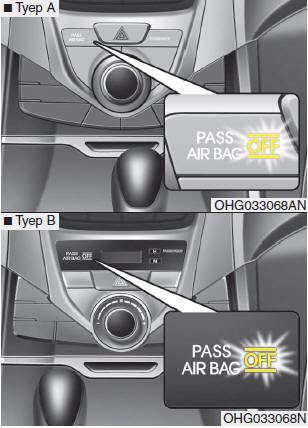
Your vehicle is equipped with an occupant classification system in the front passenger's seat.
The occupant classification system is designed to detect the presence of a properly-seated front passenger and determine if the passenger's front air bag should be enabled (may inflate) or not. The driver's front air bag is not affected or controlled by the occupant classification system.
Main components of occupant classification system
- A detection device located within the front passenger seat cushion.
- Electronic system to determine whether passenger air bag systems should be activated or deactivated.
- A warning light located on the instrument panel which illuminates the words PASS AIR BAG “OFF” indicating the front passenger air bag system is deactivated.
- The instrument panel air bag warning light is interconnected with the occupant classification system.
If the front passenger seat is occupied by a person that the system determines to be of adult size, and he/she sits properly (sitting upright with the seatback in an upright position, centered on the seat cushion with their seat belt on, legs comfortably extended and their feet on the floor), the PASS AIR BAG “OFF” indicator will turn off and the front passenger's air bag will be able to inflate, if necessary, in frontal crashes.
You will find the PASS AIR BAG “OFF” indicator on the center facia panel. This system detects conditions 1~4 in the following table and activates or deactivates the front passenger air bag based on these conditions.
Always be sure that you and all vehicle occupants are seated and restrained properly (sitting upright with the seat in an upright position, centered on the seat cushion, with the person’s legs comfortably extended, feet on the floor, and wearing the safety belt properly) for the most effective protection by the air bag and the seat belt.
- The OCS (Occupant Classification System) may not function properly if the passenger takes actions which can affect the classification system. These include:
(1) Failing to sit in an upright position.
(2) Leaning against the door or center console.
(3) Sitting towards the sides or the front of the seat.
(4) Putting legs on the dashboard or resting them on other locations which reduce
the passenger weight on the front seat.
(5) Improperly wearing the seat belt.
(6) Reclining the seat back.
Condition and operation in the front passenger occupant classification system
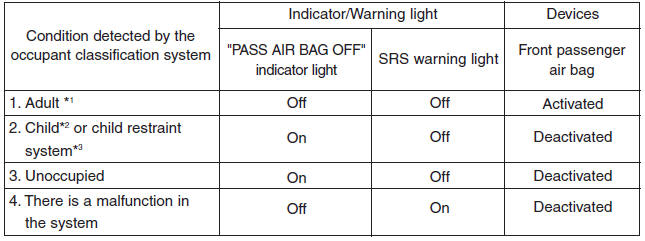
*1) The system judges a person of adult size as an adult. When a smaller adult
sits in the front passenger seat, the system may recognize him/her as a child depending
on his/her physique and posture.
*2) Do not allow children to ride in the front passenger seat. When a larger child
who has outgrown a child restraint system sits in the front passenger seat, the
system may recognize him/her as an adult depending on his/her physique or posture.
*3) Never install a child restraint system on the front passenger seat.
WARNING - OCS system
Riding in an improper position adversely affects the occupant classification system (OCS) and may result in the deactivation of front passenger airbag. It is important for the driver to instruct the passenger as to the proper seating instructions as contained in this manual.
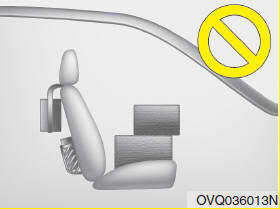
Never put a heavy load in the front passenger seat or seatback pocket.
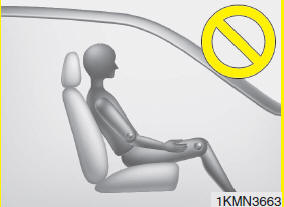
Never sit with the hips shifted towards the front of the seat.
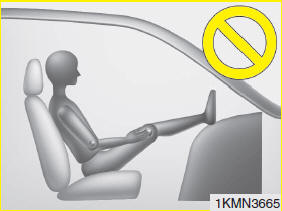
Never place the feet on the dashboard.
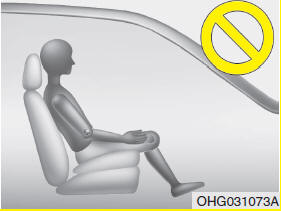
Never sit on the front passenger seat with anything attached such as a blanket or cushion.
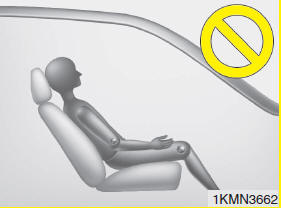
Never excessively recline the front passenger seatback.
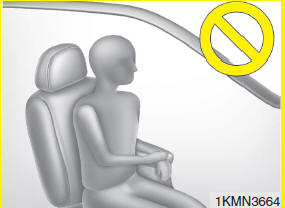
Never lean on the door or center console. Never sit on one side of the front passenger seat.
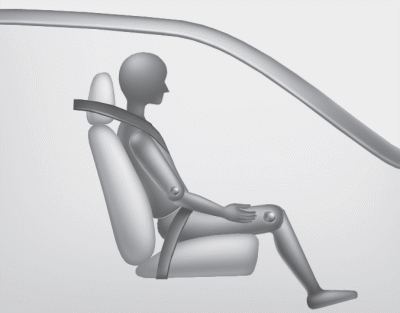
When an adult is seated in the front passenger seat, if the PASS AIR BAG “OFF” indicator is on, change the ignition switch to the OFF position and ask the passenger to sit properly (sitting upright with the seat back in an upright position, centered on the seat cushion with their seat belt on, legs comfortably extended and their feet on the floor). Restart the engine and have the person remain in that position. This will allow the system to detect the person and to enable the passenger air bag.
If the PASS AIR BAG “OFF” indicator is still on, ask the passenger to move to the rear seat.
WARNING - AIR BAG "OFF" light
Do not allow an adult passenger to ride in the front seat when the PASS AIR BAG “OFF” indicator is illuminated, because the air bag will not deploy in the event of a crash. The driver must instruct the passenger to reposition himself in the seat. Failure to properly position yourself may lead to airbag deactivation resulting in airbag non-deployment in a collision. If the PASS AIR BAG “OFF” indicator remains illuminated after the passenger repositions themselves properly and the vehicle is restarted, it is recommended the passenger move to the rear seat because the passenger's front air bag will not deploy.
✽ NOTICE
The PASS AIR BAG “OFF” indicator illuminates for about 4 seconds after the ignition switch is changed to the ON position or after the engine is started. If the front passenger seat is occupied, the occupant classification sensor will then classify the front passenger after several more seconds.
Any child age 12 and under should ride in the rear seat. Children too large for child restraints should use the available lap/shoulder belts. No matter what type of crash, children of all ages are safer when restrained in the rear seat.
✽ NOTICE
Do not modify or replace the front passenger seat. Do not place anything on or attach anything such as a blanket, front seat covers or after market seat heater to the front passenger seat. This can adversely affect the occupant classification system.
If the occupant classification system is not working properly, the SRS air bag warning light on the instrument panel will illuminate because the passenger's front air bag is connected with the occupant classification system. If there is a malfunction of the occupant detection system, the PASS AIR BAG “OFF” indicator will not illuminate and the passenger's front air bag will inflate in frontal impact crashes even if there is no occupant in the front passenger's seat.
 SRS components and functions
SRS components and functions
The SRS consists of the following components:
1. Driver's front air bag module
2. Passenger's front air bag module
3. Side impact air bag modules
4. Curtain air bag modules
5. Retract ...
 Driver's and passenger's front air bag
Driver's and passenger's front air bag
Your vehicle is equipped with an Advanced Supplemental Restraint (Air Bag) System
(SRS) and the lap/shoulder belts at both the driver and passenger seating positions.
The indications of the system ...
See also:
Components and Components Location
Components
1. Front door trim2. Front door inside handle cap3. Front door module4. Front frame inner cover5. Front door panel6. Front door side impact pad7. Front door frame garnish 8. Front doo ...
Closing the sunroof
Press the sunshade CLOSE button. The sunroof glass will close then the sunshade
will close. To stop the sunroof movement at any point, press the sunshade control
switch momentarily.
If you want ...
Power Door Mirror Actuator Repair procedures
Inspection
1.
Remove the front door quadrant delta cover.
(Refer to Body - "Front Door Trim")
2.
Disconnect the power door mirror connector from the harness.
3.
Apply battery voltage to e ...
